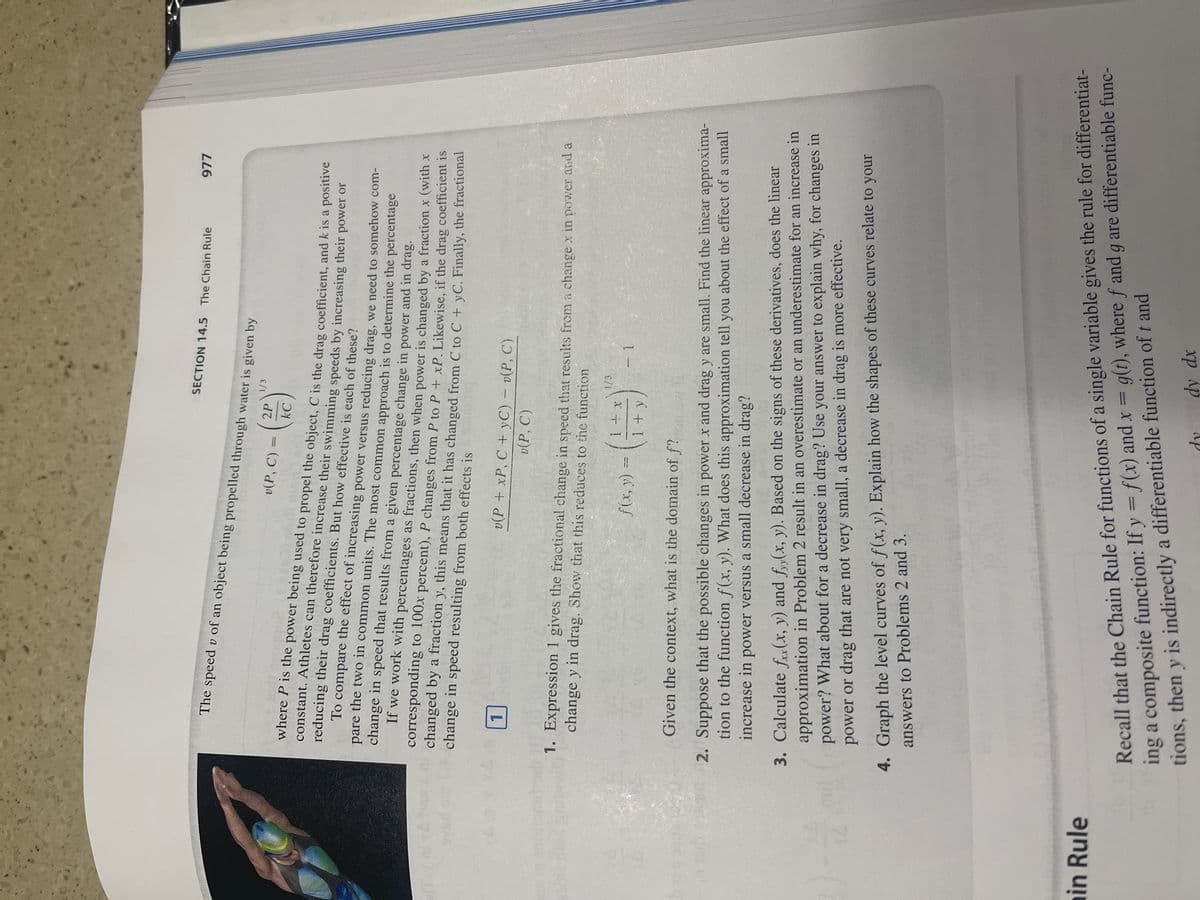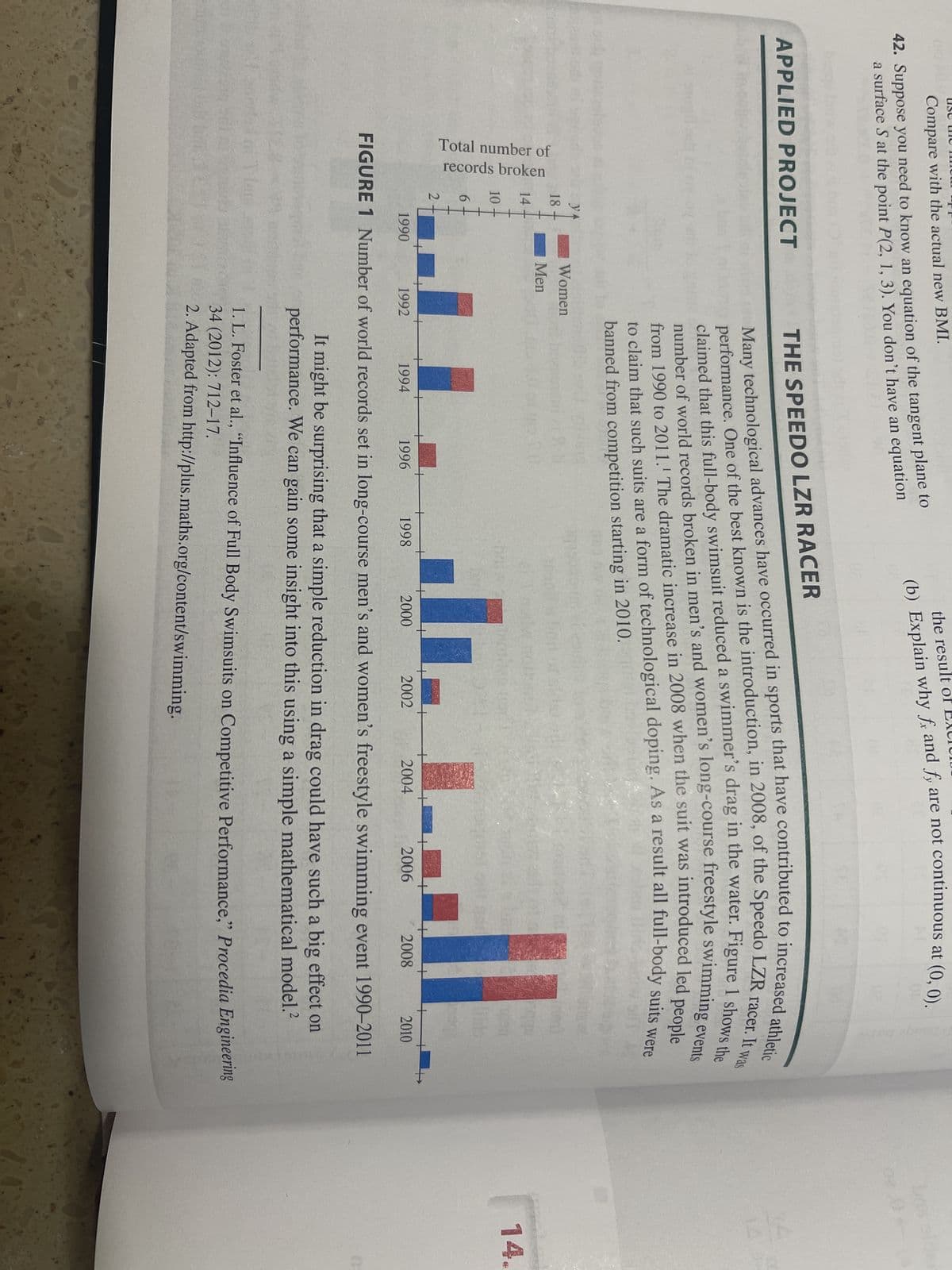The speed of an object being propelled through water is given by 1/3 v(P, C) 1 1 SECTION 14.5 The Chain Rule 2P kC where P is the power being used to propel the object, C is the drag coefficient, and k is a positive reducing their drag coefficients. But how effective is each of these? constant. Athletes can therefore increase their swimming speeds by increasing their power or To compare the effect of increasing power versus reducing drag, we need to somehow com- pare the two in common units. The most common approach is to determine the percentage change in speed that results from a given percentage change in power and in drag. If we work with percentages as fractions, then when power is changed by a fraction x (with x corresponding to 100x percent), P changes from P to P + xP. Likewise, if the drag coefficient is change in speed resulting from both effects is changed by a fraction y, this means that it has changed from C to C + yC. Finally, the fractional v(P+xP, C+ yC) - v(P, C) v(P, C) 977 1. Expression 1 gives the fractional change in speed that results from a change x in power and a change y in drag. Show that this reduces to the function 1/3 F(x, y) = (1+1) <-1 Given the context, what is the domain of f? 2. Suppose that the possible changes in power x and drag y are small. Find the linear approxima- tion to the function f(x, y). What does this approximation tell you about the effect of a small increase in power versus a small decrease in drag? 3. Calculate f(x, y) and f(x, y). Based on the signs of these derivatives, does the linear approximation in Problem 2 result in an overestimate or an underestimate for an increase in power? What about for a decrease in drag? Use your answer to explain why, for changes in power or drag that are not very small, a decrease in drag is more effective. 4. Graph the level curves of f(x, y). Explain how the shapes of these curves relate to your answers to Problems 2 and 3.
The speed of an object being propelled through water is given by 1/3 v(P, C) 1 1 SECTION 14.5 The Chain Rule 2P kC where P is the power being used to propel the object, C is the drag coefficient, and k is a positive reducing their drag coefficients. But how effective is each of these? constant. Athletes can therefore increase their swimming speeds by increasing their power or To compare the effect of increasing power versus reducing drag, we need to somehow com- pare the two in common units. The most common approach is to determine the percentage change in speed that results from a given percentage change in power and in drag. If we work with percentages as fractions, then when power is changed by a fraction x (with x corresponding to 100x percent), P changes from P to P + xP. Likewise, if the drag coefficient is change in speed resulting from both effects is changed by a fraction y, this means that it has changed from C to C + yC. Finally, the fractional v(P+xP, C+ yC) - v(P, C) v(P, C) 977 1. Expression 1 gives the fractional change in speed that results from a change x in power and a change y in drag. Show that this reduces to the function 1/3 F(x, y) = (1+1) <-1 Given the context, what is the domain of f? 2. Suppose that the possible changes in power x and drag y are small. Find the linear approxima- tion to the function f(x, y). What does this approximation tell you about the effect of a small increase in power versus a small decrease in drag? 3. Calculate f(x, y) and f(x, y). Based on the signs of these derivatives, does the linear approximation in Problem 2 result in an overestimate or an underestimate for an increase in power? What about for a decrease in drag? Use your answer to explain why, for changes in power or drag that are not very small, a decrease in drag is more effective. 4. Graph the level curves of f(x, y). Explain how the shapes of these curves relate to your answers to Problems 2 and 3.
Trigonometry (MindTap Course List)
10th Edition
ISBN:9781337278461
Author:Ron Larson
Publisher:Ron Larson
Chapter6: Topics In Analytic Geometry
Section6.2: Introduction To Conics: parabolas
Problem 4ECP: Find an equation of the tangent line to the parabola y=3x2 at the point 1,3.
Related questions
Question
Problems 1-5 of this applied project.

Transcribed Image Text:ovad
100-13
Eshic die
13 1505 224910
in Rule
The speed v of an object being propelled through water is given by
1/3
1
SECTION 14.5 The Chain Rule
2P
kC
v(P, C) =
where P is the power being used to propel the object, C is the drag coefficient, and k is a positive
reducing their drag coefficients. But how effective is each of these?
constant. Athletes can therefore increase their swimming speeds by increasing their power of
To compare the effect of increasing power versus reducing drag, we need to somehow com-
pare the two in common units. The most common approach is to determine the percentage
change in speed that results from a given percentage change in power and in drag.
If we work with percentages as fractions, then when power is changed by a fraction x (with x
corresponding to 100x percent), P changes from P to P + xP. Likewise, if the drag coefficient is
change in speed resulting from both effects isung
changed by a fraction y, this means that it has changed from C to C + yC. Finally, the fractional
v(P + xP, C + yC) − v(P, C)
v(P, C)
f(x, y)
1. Expression 1 gives the fractional change in speed that results from a change x in power and a
change y in drag. Show that this reduces to the function
-
977
1/3
x
-(1)
y
- 1
Given the context, what is the domain of f?
2. Suppose that the possible changes in power x and drag y are small. Find the linear approxima-
tion to the function f(x, y). What does this approximation tell you about the effect of a small
increase in power versus a small decrease in drag?
3. Calculate fxx (x, y) and fyy(x, y). Based on the signs of these derivatives, does the linear
approximation in Problem 2 result in an overestimate or an underestimate for an increase in
power? What about for a decrease in drag? Use your answer to explain why, for changes in
power or drag that are not very small, a decrease in drag is more effective.
4. Graph the level curves of f(x, y). Explain how the shapes of these curves relate to your
answers to Problems 2 and 3.
Recall that the Chain Rule for functions of a single variable gives the rule for differentiat-
ing a composite function: If y = f(x) and x = g(t), where f and g are differentiable func-
tions, then y is indirectly a differentiable function of t and
dy dx

Transcribed Image Text:Compare with the actual new BMI.
42. Suppose you need to know an equation of the tangent plane to
a surface S at the point P(2, 1, 3). You don't have an equation
APPLIED PROJECT
Total number of
records broken
y
18
14
...............
2000
2002
FIGURE 1 Number of world records set in long-course men's and women's freestyle swimming event 1990–2011
It might be surprising that a simple reduction in drag could have such a big effect on
performance. We can gain some insight into this using a simple mathematical model.²
10
2
--
1990
THE SPEEDO LZR RACER
performance. One of the best known is the introduction, in 2008, of the Speedo LZR racer. It was
Many technological advances have occurred in sports that have contributed to increased athletic
claimed that this full-body swimsuit reduced a swimmer's drag in the water. Figure 1 shows the
number of world records broken in men's and women's long-course freestyle swimming events
to claim that such suits are a form of technological doping. As a result all full-body suits were
from 1990 to 2011.' The dramatic increase in 2008 when the suit was introduced led people
banned from competition starting in 2010.
Women
Men
1992
1994
the result of
(b) Explain why fx and fy are not continuous at (0, 0).
1996
02
1998
2004
2006
2008
2006
2010
1. L. Foster et al., "Influence of Full Body Swimsuits on Competitive Performance, Procedia Engineering
34 (2012): 712-17.
2. Adapted from http://plus.maths.org/content/swimming.
bris olde
02.0
14.
Expert Solution
This question has been solved!
Explore an expertly crafted, step-by-step solution for a thorough understanding of key concepts.
Step by step
Solved in 2 steps

Recommended textbooks for you

Trigonometry (MindTap Course List)
Trigonometry
ISBN:
9781337278461
Author:
Ron Larson
Publisher:
Cengage Learning

Trigonometry (MindTap Course List)
Trigonometry
ISBN:
9781337278461
Author:
Ron Larson
Publisher:
Cengage Learning